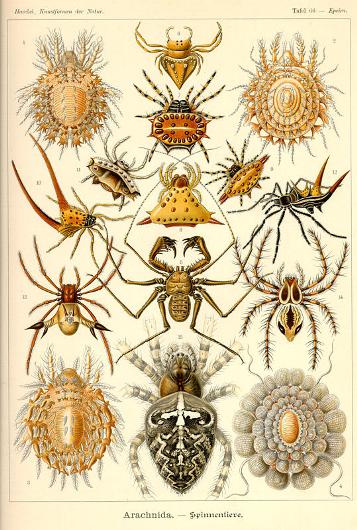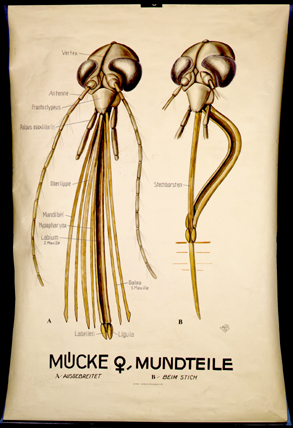Welcome to my weblog, and to the fourteenth edition of Circus of the Spineless. I’ve got a veritable orgy of all things wiggly, wriggly and crawly lined up, and, as it’s Halloween, I’ve got some treats for you as well. I received some fantastic submissions, so let’s get down and dirty in the undergrowth, and see what’s been happening in the invertebrate blogosphere in recent weeks.
Marcus sent in a heap of excellent posts from his blog The Annotated Budak, including two of my favourite submissions: the first contains two photographs of jumping spiders, one of which mimics an ant, and the second has pics of a tiger beetle and the insects it preys upon. I had a hard time deciding which of Marcus’s posts to leave out, so there’ll be more from him later on.
The spider in Marcus’s first post may look like an ant, and, being a jumping spider, I’m sure it can jump, but I don’t think it can mimic the amazing acrobatics of the trap-jaw ant captured in this high-speed camera footage.
Next up, Fred First has a few Fragments from Floyd County, Virginia for us (how’s that for alliteration?). While testing the macro capabilities of Anna’s new camera, Fred got up close and personal with an Assassin bug. Revisiting Fred’s blog today, I found this fantastic post, and couldn’t resist including it here. (By strange coincidence, Fred submitted the same post just as I was carrying out the final edit of this the post!) I also noticed that Fred hails from Birmingham, Alabama, which is, I believe, where the brilliant Edward O. Wilson comes from.
Now let’s take a little ramble with Julie, who found some ant hills while Walking Prescott. While we’re out and about, let’s join Pamela on one of her Thomasburg Walks. Last time she went on a walk, she took some photos of stick insects, which then got buried in a folder on her computer. Fortunately, she’s re-discovered them. Then let’s jet over to South East Asia to see some Indonesian insects, courtesy of Marcus; and while we’re in that part of the world, let’s drop in to see Satoshi Kuribayashi, the winner of this year’s Lennart Nilsson scientific photography award.
AN INCREDIBLE SIDESHOW
Let’s take a little break from the festivities for an incredible sideshow. After all, what’s a carnival without a sideshow?
The UK History Channel devoted all of last Sunday to Life in The Undergrowth, the most recent series by David Attenborough, the doyen of natural history documentaries. I hit the play button on my VCR at about 3pm, and recorded 7 whole hours of this outstanding series. For anyone who hasn’t seen it, here’s a short clip from the series. Marvel at the truly spectacular sight of a pair of leopard slugs mating:
 There are quite a few submissions about butterflies and moths this month. Enough, I think, to justify this plate from James Edward Smith’s The Natural History of the Rarer Lepidopterous Insects of Georgia, published in 1797. Take a look at the other plates from this beautiful book – there are 100 in all.
There are quite a few submissions about butterflies and moths this month. Enough, I think, to justify this plate from James Edward Smith’s The Natural History of the Rarer Lepidopterous Insects of Georgia, published in 1797. Take a look at the other plates from this beautiful book – there are 100 in all.
While you’re there, I strongly recommend that you check out the wonderful digital collection of rare books at the Missouri Botanical Garden library. I’ve spent hours browsing this outstanding website – you should too!
Grrl Scientist, who is Living the Scientific Life, gives us a pictorial lesson on how to distinguish between the Sleepy Orange butterfly and the Clouded Sulphur.
Urban Dragon Hunter Nannothemis has some nice photos of dragonflies spotted in Mexico.
Cindy provides us with some beautiful photographs of maples and moths from her blog, Woodsong – Off the Beaten Path. Check out more of Cindy’s superb nature photography at her website.
Over at his photoblog, David Nelson has some scanning electron micrographs of the scales on butterfly wings and a couple of photos of a blue planarian.
At Jennifer’s Invasive Species Weblog, there’s a discussion of – you’ve guessed it – an invasive species! This time its a parasitic fly that was introduced to the United States over a hundred years ago in an attempt to control the gypsy moth.
FOCUS: HONEYBEE GENOME
Let’s take another little break from the proceedings to focus on the honeybee genome, which was published in the journal Nature earlier this month. The research paper containing the genome sequence is freely accessible, as are several items in the journal’s Honeybee genome Web Focus. The current issue of Insect Molecular Biology is devoted to the honeybee genome and is also freely accessible.
This post I wrote summarizes the paper and contains some information on the honeybee brain, as well as some nice links.
 The plate on the left is from Ernst Hackel’s remarkable Kunstformen der Natur (Artforms in Nature). The book contains 99 others – be sure to take a look, after you’ve perused the posts about spiders and various other invertebrates.
The plate on the left is from Ernst Hackel’s remarkable Kunstformen der Natur (Artforms in Nature). The book contains 99 others – be sure to take a look, after you’ve perused the posts about spiders and various other invertebrates.
First, let’s take A Snail’s Eye View of an Australian spider, and then read an illustrated excerpt from Don Marquis’s A Spider and a Fly.
Marcus gives us a photo of a lynx spider and another of a fly; the last post from him is about a recent paper which shows that adult midges stop producing heat shock protein continuously, and express the hsp genes only when stressed.
David also has some very nice photographs of spiders spinning webs and catching flies over at Science and Sensibility; and here’s something I wrote about those amazing arachnids.
At Science Made Cool, Diane has a short post about headlice, while over at Snail’s Tales, Aydin has some pics of a couple of snails making a meal of a big pile of…well, use your imagination.
And finally, from the Dax Files blog, a few pics of an incredible, and incredibly furry, caterpillar, crawling across the carpet. This post was actually submitted to Encephalon, the neuroscience carnival, by mistake.
Wait! Hold the front page! Here’s a last minute entry from David Nelson, who’s put his ~70mm extension tube and macro lens to excellent use to capture this close-up of an emerald cuckoo wasp.
And there you have it. While you’re here, why not take a look around. Perhaps you’d like to browse my multimedia gallery and watch a film or two, and subscribe to my RSS feed.
Thanks to everyone who submitted entries. I’ve had a lot of fun compiling them and I’ve discovered some excellent blogs. The next edition of Circus of the Spineless will be at Ocellated in a month.
Other carnivals I’ve hosted:


Pingback: The Dax Files
Great Circus! I love the illustrations. Thanks for including me.
Sensational work! This is going to be an excellent distraction …
Pingback: 10000birds
Pingback: Watermark
Pingback: Watermark
Pingback: Watermark
Pingback: Watermark